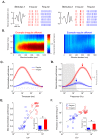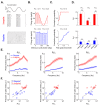Coding strategies in the otolith system differ for translational head motion vs. static orientation relative to gravity
- PMID: 31199243
- PMCID: PMC6590985
- DOI: 10.7554/eLife.45573
Coding strategies in the otolith system differ for translational head motion vs. static orientation relative to gravity
Abstract
The detection of gravito-inertial forces by the otolith system is essential for our sense of balance and accurate perception. To date, however, how this system encodes the self-motion stimuli that are experienced during everyday activities remains unknown. Here, we addressed this fundamental question directly by recording from single otolith afferents in monkeys during naturalistic translational self-motion and changes in static head orientation. Otolith afferents with higher intrinsic variability transmitted more information overall about translational self-motion than their regular counterparts, owing to stronger nonlinearities that enabled precise spike timing including phase locking. By contrast, more regular afferents better discriminated between different static head orientations relative to gravity. Using computational methods, we further demonstrated that coupled increases in intrinsic variability and sensitivity accounted for the observed functional differences between afferent classes. Together, our results indicate that irregular and regular otolith afferents use different strategies to encode naturalistic self-motion and static head orientation relative to gravity.
Keywords: neural coding; neuroscience; otolith afferents; rhesus macaque; self-motion; spike timing; tilt; translation.
© 2019, Jamali et al.
Conflict of interest statement
MJ, JC, MC, KC No competing interests declared
Figures









Similar articles
-
Gravity dependence of subjective visual vertical variability.J Neurophysiol. 2009 Sep;102(3):1657-71. doi: 10.1152/jn.00007.2008. Epub 2009 Jul 1. J Neurophysiol. 2009. PMID: 19571203
-
Three-dimensional organization of otolith-ocular reflexes in rhesus monkeys. I. Linear acceleration responses during off-vertical axis rotation.J Neurophysiol. 1996 Jun;75(6):2405-24. doi: 10.1152/jn.1996.75.6.2405. J Neurophysiol. 1996. PMID: 8793753
-
Strong correlations between sensitivity and variability give rise to constant discrimination thresholds across the otolith afferent population.J Neurosci. 2013 Jul 3;33(27):11302-13. doi: 10.1523/JNEUROSCI.0459-13.2013. J Neurosci. 2013. PMID: 23825433 Free PMC article.
-
Otolith adaptive responses to altered gravity.Neurosci Biobehav Rev. 2021 Mar;122:218-228. doi: 10.1016/j.neubiorev.2020.10.025. Epub 2020 Nov 3. Neurosci Biobehav Rev. 2021. PMID: 33152424 Review.
-
Gravity or translation: central processing of vestibular signals to detect motion or tilt.J Vestib Res. 2003;13(4-6):245-53. J Vestib Res. 2003. PMID: 15096668 Review.
Cited by
-
Function of bidirectional sensitivity in the otolith organs established by transcription factor Emx2.Nat Commun. 2022 Oct 24;13(1):6330. doi: 10.1038/s41467-022-33819-3. Nat Commun. 2022. PMID: 36280667 Free PMC article.
-
A prosthesis utilizing natural vestibular encoding strategies improves sensorimotor performance in monkeys.PLoS Biol. 2022 Sep 14;20(9):e3001798. doi: 10.1371/journal.pbio.3001798. eCollection 2022 Sep. PLoS Biol. 2022. PMID: 36103550 Free PMC article.
-
Tiltable objective microscope visualizes selectivity for head motion direction and dynamics in zebrafish vestibular system.Nat Commun. 2022 Dec 21;13(1):7622. doi: 10.1038/s41467-022-35190-9. Nat Commun. 2022. PMID: 36543769 Free PMC article.
-
The neural basis for violations of Weber's law in self-motion perception.Proc Natl Acad Sci U S A. 2021 Sep 7;118(36):e2025061118. doi: 10.1073/pnas.2025061118. Proc Natl Acad Sci U S A. 2021. PMID: 34475203 Free PMC article.
-
Using macular velocity measurements to relate parameters of bone conduction to vestibular compound action potential responses.Sci Rep. 2023 Jun 23;13(1):10204. doi: 10.1038/s41598-023-37102-3. Sci Rep. 2023. PMID: 37353559 Free PMC article.
References
Publication types
MeSH terms
Associated data
Grants and funding
LinkOut - more resources
Full Text Sources

